Disability benefits evaluation - case transfer: evaluation
A report on the evaluation of the case transfer process for those in receipt of Adult Disability and Child Disability Payment
Findings
This chapter explores evidence from the data sources described in the methodology chapter to evaluate progress towards the short-, medium- and long-term policy outcomes. Where there is overlap between different outcomes within the relevant section, these are discussed together.
Progress towards short-term outcomes
The short-term outcomes explored in this section include:
- Individuals understand what is happening and when.
- Individuals feel throughout that the transfer is safe and secure (i.e., the right amount is paid on time)
- Individuals know who to contact for help and support.
- Individuals understand what they need to do (when appropriate) or are reassured that they don’t need to do anything.
- Individuals do not feel undue stress/anxiety about the transfer and review elements of the process.
- Experience of the process is in line with dignity, fairness and respect.
- Individuals have a positive experience of the review process.
Individuals understand what is happening and when and Individuals understand what they need to do (when appropriate) or are reassured that they don’t need to do anything
These short-term outcomes relate to the experience of the case transfer process specifically.
The qualitative research largely explored clients’ understanding of the case transfer process from initial contact through to receiving their outcome letter. However, there were some clients who had heard about the case transfer process before initial contact; some of these clients had contacted the DWP or Social Security Scotland to find out more information. Communication with Social Security Scotland staff and receipt of the introduction letter in due course provided clarity and reassurance. In 2022-23, 84 per cent of client survey respondents ‘strongly agreed’ or ‘agreed’ they felt informed about the case transfer process, 9 per cent ‘neither agreed or disagreed’ and 7 per cent ‘strongly disagreed’ or ‘disagreed.
Interviewed clients generally felt the introduction letter had been clear and informative. However, staff recognised that the length of the letter made it difficult for clients to understand everything. Support organisations also reflected that a common issue across clients is the difficulty they face in understanding the letters they receive (for both case transfer and review), with specific groups being mentioned as experiencing these difficulties more frequently. Interviews with clients and support organisations identified other factors which contributed to reduced clarity, including:
- Not receiving an introduction letter (reported by a few clients)
- Perceptions of miscommunication between the DWP and Social Security Scotland (discussed below)
- Receiving letters or communication in error or not receiving all the information (e.g. letters without forms)
- Information in the outcome letter about informing other agencies about change to ADP or CDP. Some clients also felt it should not be their responsibility.
Clients who were transferring because they reported a change in circumstances had a distinct experience. Their worry about the process is discussed later in the chapter. In relation to their understanding, there was evidence from both clients and support organisations that they had received inconsistent information from the DWP and Social Security Scotland. For example, being told different information about who, how and when to report changes in their condition.
Staff also reported that there was a lack of clarity from both staff and clients regarding reporting a change of circumstances during case transfer. They suggested that client experience could be improved if Social Security Scotland were able to accept a change of circumstances from the DWP, rather than having to process this for the first time during the review.
Client survey data also pointed to differences in experiences by the benefit clients were transferring from/to. Whilst clients transferring to CDP were most likely to agree that the communication they received about the case transfer process was clear and easy to understand and helped them to understand what was happening and why, those transferring from DLA to ADP were least likely to agree (see Figure 4).
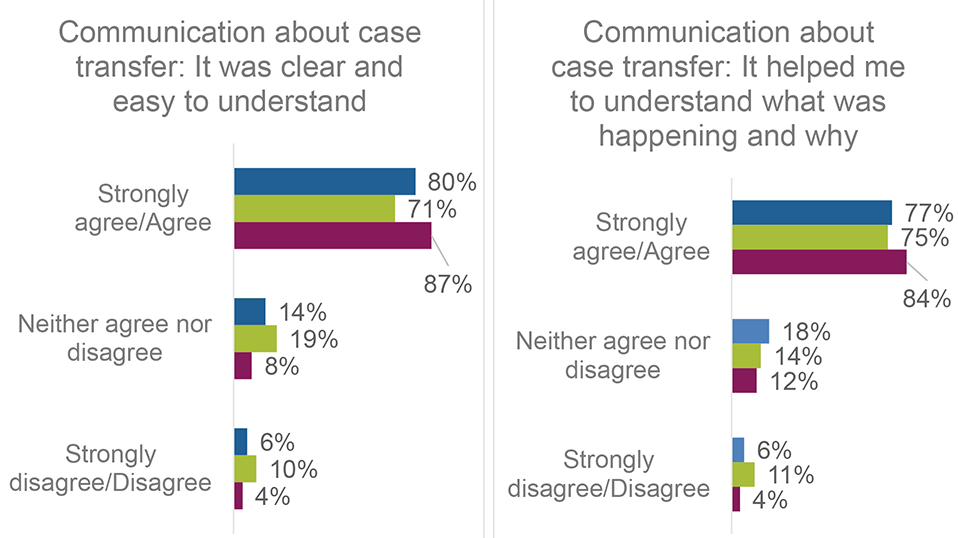
Individuals know who to contact for help and support
Clients reported being aware of the sources of support listed in the introduction letter but had not generally sought this out because they were satisfied with the information provided.
However, there were a few exceptions.
- One client could not find a phone number to speak to anyone directly about the transfer process.
- There was some confusion about whether to contact Social Security Scotland or the DWP during case transfer (discussed above)
In the client survey, whilst 58 per cent of respondents ‘strongly agreed’ or ‘agreed’ they felt supported during the case transfer process, around a third (31 per cent) said they ‘neither agreed or disagreed’ and 11 per cent ‘strongly disagreed’ or ‘disagreed’. This suggests a more mixed experience of support including feelings of indifference.
During the review process, clients reported using a range of sources of support, from existing networks through to local delivery staff. Clients who had experience of support from local delivery spoke very positively about this experience:
“There is no way I would have been able to tackle that booklet on my own.” (DLA client)
Support organisations reported that the most common problem clients face when they do try to seek support, advice or guidance from Social Security Scotland was long call waiting times and related issues with using the online chat function. For these organisations who are trying to help clients directly, they also experienced challenges in contacting Social Security Scotland on clients’ behalf. In addition, support organisations mentioned particular difficulties with the mandate process which they viewed as more restrictive than the process required through the DWP.
"… we've got clients who have tried to call but because of their mental health they're not understanding and being on hold for, and to be fair my calls recently have taken 40 minutes instead of an hour which it was taking, an hour or more before, so the wait time has dropped a bit but it's still plus 40 minutes and it's too much for some people to be in a clear state of mind by the time they get through" (Support Organisation)
Individuals feel throughout that the transfer is safe and secure (i.e. the right amount is paid on time)
Across interviews with both clients and support organisations and responses to the client survey, there was evidence that strongly supported the finding that the case transfer had been experienced as safe and secure. None of the clients interviewed reported any issues with their disability benefit payment during the case transfer. Clients reported their payments to be continuous and also experienced as “safe and secure” in that the payments had been made at the correct time. Support organisations similarly reported that clients had continued to receive their payments on time and as expected. The client data showed that over 97 per cent of case transfer clients reported receiving the right amount of payments when they were told they would. There were no differences between those transferring to CDP or ADP.
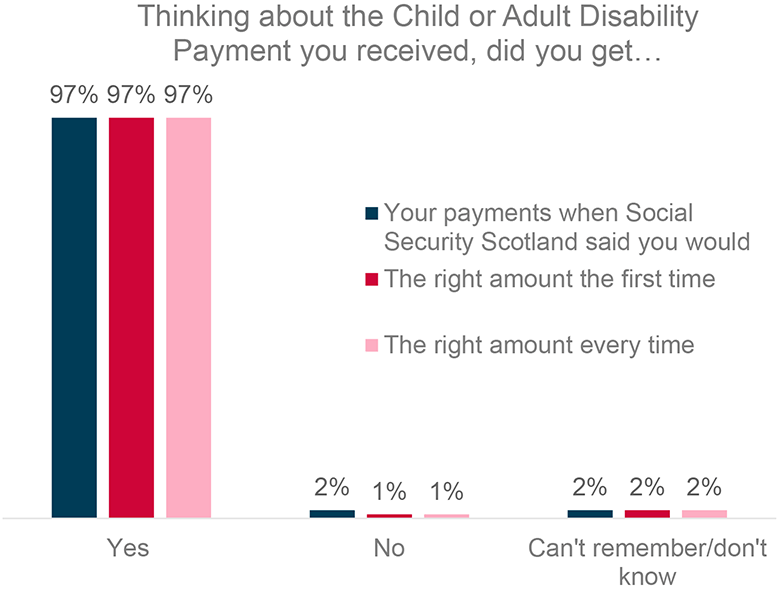
Nevertheless, other related issues were highlighted by both clients and support organisations, including:
- The change in payment day caused some anxiety for clients.
- Some clients did report issues with other benefits or support.
- Perceived errors in the backdating of payments
For example, some clients interviewed reported cases where the DWP had stopped or said they were going to stop, parents’ Carer’s Allowance because they were no longer in receipt of DLAC.
“I got a letter from the Department of Work and Pensions to tell me that my Carer’s Allowance was due to stop…when I phoned them, they were like, ‘oh no, it is fine, we can see in the background that it is going to move over to Scotland, we just haven’t updated the system yet’ but you can imagine, I was like, ‘oh my God, they can’t stop my Carer’s Allowance’. I’m dependent on that money to pay for electricity and things, because I can’t work full time.” (DLAC client)
Individuals do not feel undue stress/anxiety about the transfer and review elements of the process and Experience of the process is in line with dignity, fairness and respect
In the interviews, some clients expressed hope or expectation that they would be treated better by Social Security Scotland in comparison to their experiences with the DWP.
“[I felt] okay I suppose, obviously a little anxious because with the DWP they were very un-trusting so it always felt like it was an uphill battle. I know [Social Security Scotland] had said it would be done with more fairness and things like that, but it was still kind of in the back of your head, ‘oh what if I lose this’.” (PIP client)
The style and content of the letters from Social Security Scotland helped to ease any concern. Over four-fifths (84 per cent) of client survey respondents ‘strongly agreed’ or ‘agreed’ that the tone of the communication received about their case transfer was friendly. In the interviews, clients said they were reassured by information that their payments would be continuous throughout the review process. Clients also commented that they were more welcoming than those they had received from the DWP, pointing to the references of ‘dignity, fairness and respect’.
“…their [Social Security Scotland] logos and everything are quite bright and welcoming... the DWP seems very kind of tax like, very money orientated… Whereas this one seems a lot more personal to the fact that you need something to help your family.” (DLAC client)
Other clients were concerned about the case transfer and review process. With the review, this often stemmed from a general concern that their payments could stop. There were factors which contributed to any anxiety or concern clients had about the case transfer and review process. This included:
- Missing letters or receiving incorrect information
- Limited clarity and communication about the progress of their case transfer (linked to requests for a tracking system)
- Difficulties contacting Social Security Scotland, including long wait times.
- Issues with other benefits or support during case transfer (discussed above)
- Length of the change of circumstances form, particularly for clients transferring from DLA
Interviews with staff suggested that anxiety for clients could also come from lack of understanding about specific aspects of the review process. One area in particular that they felt both staff and clients were unclear about was the process for backdating payments relating to a change in circumstances. Support organisations also reflected that clients were unclear about the process of backdating and suggested there could be more and improved communication about this aspect to ease anxiety and increase understanding.
Support organisations stated that clients reporting a change in circumstances and those transferring from DLA to ADP were more likely to have worries or concerns about the case transfer and review process. Common worries are around payments, including whether payments will stop or reduce and how payments would be backdated.
"All that takes 3 or 4 months. At what point does the client get his hands on the change of circumstance form cause let’s not forget, that's why he made the initial call. I've found I've had to get clients to phone up Social Security Scotland to chase up that form. Cause some of the rhetoric I'm getting back, some of the feedback from Social Security Scotland is you don't need to worry about it until we've formally transferred you but that could be months away. But another call handler said "no [name] get the client to do the form now, it'll come to us, but we won't assess it until the actual effective date of ADP. So, it sits in the pending tray then. And then the question is, does that get backdated to the day he made the phone call? I think it does but I'm a little bit unsure" (Support Organisation)
The survey data also pointed to differences between clients by the benefit they were transferring from/to. Over half of those transferring from PIP or DLA to ADP (57 per cent and 51 per cent respectively) 'strongly agreed' or 'agreed' that being case transferred made them feel anxious, compared to around a third (33 per cent) of those transferring to CDP. Positively, almost three quarters (73 per cent) of PIP to ADP clients and 81 per cent of clients transferring to CDP 'strongly agreed' or 'agreed' that they felt reassured by the process. However, whilst only 6 per cent of those transferring to CDP 'strongly disagreed' or 'disagreed' that they felt reassured, this compared to 14 per cent of those transferring from DLA to ADP.
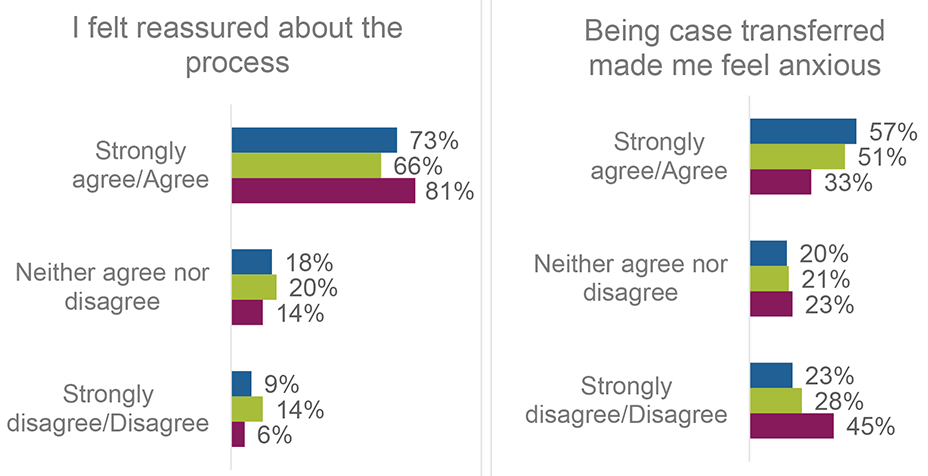
Individuals have a positive experience of the review process
As mentioned above, interviewed clients expressed mixed feelings about the prospect of a review; clients transferring from DLA to ADP tended to express greater anxiety about the process as many had been on indefinite awards and had not had a review for a long time (or ever). Interviews with support organisations also echoed this.
Type of transfer (i.e. from DLA or PIP to ADP) and circumstances of transfer (i.e., change of circumstances versus being due a review) intersected to create particular experiences of the review process. For example, clients transferring from DLA reporting a change in circumstances found the timescales lengthy and stressful. By comparison, despite staff reporting that timescales for reviews typically took longer for those transferring from PIP (due to the amount time required to process existing information from the DWP), clients themselves felt the timescales met or exceeded their expectations. In general, clients transferring from PIP considered the review process to be easier than they thought it would be, describing it as “easy”, “uncomplicated” and “streamlined”.
Those reporting a change of circumstances tended to report more difficulties than those transferring because they were due a review (i.e. unscheduled versus scheduled reviews). Support organisations also reported this. Across interviews with clients and support organisations, the challenges reported included:
- The form which was described as “lengthy”, “stressful” and “tiresome” to complete.
- The lack of online option to complete (reducing accessibility for those with certain disabilities)
- Lengthy timescales. This challenge was specific to clients transferring from DLA who reported a change in circumstances. These clients viewed the wait as being from the time they informed the DWP of their change in circumstances to the time they were provided with an outcome by Social Security Scotland.
- Delays or issues in getting access to other benefits or support, including cars, bus passes and housing benefits whilst waiting for outcome of their review. Despite staff reporting they would try and mitigate these knock-on impacts by bringing reviews forward, these experiences were reported by clients regardless of their type or circumstance of transfer.
- Uncertainty around timescales for the review process contributed to anxiety about the outcome.
"All that time waiting, it gets them ticking over in their head, is my money going to be stopped, what's going to be happening … a lot of questions. It's also causing problems for blue badges so for automatic entitlement for blue badges you need at least a year on your award ... we can't tell the blue badge team how long is left on an award because we don't know" (Support Organisation)
Progress towards medium-term outcomes
The previous section focussed largely on clients’ direct experience of the case transfer and review process. This section focusses primarily on clients’ follow up views and experiences. For example, what impact did their experiences have on how they feel they have been treated, their beliefs in how they will be treated going forwards and their developing attitudes towards Social Security Scotland. The latter will be explored further in the section on long-term impacts.
The medium-term outcomes explored in this section include:
- Individuals understand what happens next.
- Individuals develop a positive relationship with Social Security Scotland
- Individuals experience reduced stress and/or anxiety about the prospect of future reviews or assessments.
- Individuals feel that decision making is fair and transparent.
- Individuals feel treated with dignity, fairness and respect.
Individuals understand what happens next
Understanding of the case transfer process was explored under short-term outcomes. This outcome focusses on clients’ understanding of the first review following case transfer.
Interviews with clients revealed mixed understandings and expectations of the review process, based on information contained within the letter received at the point case transfer was complete. Some clients felt the review letter explained clearly what would happen next. However, other clients did not think the review process was explained clearly.
One particular example of misunderstanding came from clients who had received both a declaration form (where they would state no change to circumstances) and a change of circumstances form. Staff reported that it was fairly common for clients to complete both of these forms, leading to delays in processing due to the conflicting information.
Other factors which contributed to reduced clarity about the review process included:
- Receiving the wrong forms
- Length of the initial letter about the review process
- Lack of understanding amongst both clients and staff with regard to the backdating of payments following reporting a change in circumstances to the DWP.
“Because I’ve transferred over to the Scottish Adult [ADP], they can only backdate my money that I’m due [from] the start of my review, which I found quite unfair. I have been waiting for this to take place and I have waited, and I’ve waited and I’ve waited.” (DLA client)
Individuals develop a positive relationship with Social Security Scotland
Following their case transfer, some clients did not express any particular positive or negative view of Social Security Scotland. They felt that their new benefit was ‘just the same thing with a different name’, or that they were happy as long as their benefit payment continued.
Other clients had developed a positive view of Social Security Scotland, as illustrated in the following quote:
“I feel that I’m less likely to suddenly get a letter through the door saying it is all going to stop…they were really good and treated me like a human being, which is great, and I’ve never had that…a feeling of being a person when I’ve spoken to the DWP.” (DLA client)
There were some aspects of the experience that seemed to contribute to a positive view of Social Security Scotland, including:
- A smooth case transfer process
- Friendly and helpful staff that made it easy to reach out to
- A belief that Social Security Scotland does what it says it will.
- Support for the devolution of benefits in general
- A feeling that benefits are less likely to stop alongside greater prospect of being awarded future support.
In contrast, one interviewed client noted that their trust in Social Security Scotland had declined slightly due to lack of updates on progress. Issues with communication and getting through to Social Security Scotland were highlighted earlier. More positively, support organisations reflected that once they had managed to make contact with Social Security Scotland, they generally had a good experience.
“The call centre staff in the Glasgow teams in Social Security Scotland have all been brilliant. They’ve all been very empathetic, very caring, kind on the phone…so many of our clients who were on PIP previously and were being administered by DWP told me of so many negative experiences on the telephone calls with staff.” (Support Organisation)
The client survey asked respondents if the communication they received from Social Security Scotland about their case transfer made them feel confident they could approach them if they had a query. Nearly four-fifths (79 per cent) ‘strongly agreed’ or ‘agreed’ and there were some differences by the benefit clients were transferring from (see Figure 7).
Other groups were also more likely to ‘strongly agree’ or ‘agree’ with this statement, including:
- Women (78 per cent) compared to men (73 per cent)
- Those who lived at postcode categorised as SIMD quintile 1 (most deprived – 81 per cent) compared to those in quintile 5 (least deprived – 74 per cent)
- Those from a minority ethnic background (86 per cent) compared to white respondents (76 per cent)
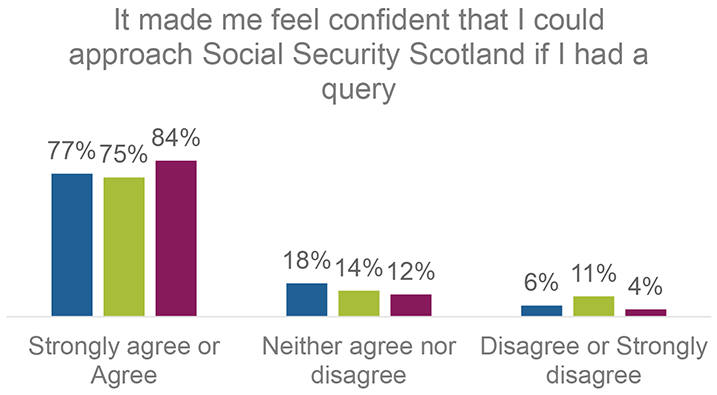
Individuals experience reduced stress and/or anxiety about the prospect of future reviews or assessments
As noted earlier, clients reported anxiety about the review process, largely stemming from a concern that payments would stop. Some of this worry remained.
For clients who had received the outcome from their review that they were expecting or had received a higher award, there was a clear sense of relief. Clients reported feeling able to move on with their lives, secure in the knowledge that their payments would continue and that their situation had been “recognised” by Social Security Scotland. One client said the outcome had boosted their spirits and enabled them to move forward with their plans, as the process had not taken as much energy as they thought it might have.
“It actually spurred me on to apply for University […] that I would say is thanks to the review actually [and] me having enough energy, because I wasn’t put through a meat grinder over the course of the process.” (PIP client)
Individuals feel that decision making is fair and transparent
Across interviews with clients, attitudes towards fair decision making were generally related to whether the outcome met clients’ expectations. Where nothing changed with a clients’ award (and they were expecting this) or where an award was increased, feelings about the outcome were generally positive. There was a broad perception that Social Security Scotland had considered their needs, conducted the review fairly and made the right decision first time.
“It made me reassured and not doubting what’s happening. I have 100 per cent confidence in Social Security Scotland to make the right decision. As soon as I told them, they took it all on board. Nothing was left out and it happened quickly.” (PIP client)
Where nothing changed with an award, but they had hoped for an increase, clients expressed feelings of disappointment. They were less likely to feel that Social Security Scotland had considered their circumstances or that the decision was fair. Where other forms of support or communication about other benefits had been impacted during the review process, this added further to their sense of frustration.
“I need more help now. I put down everything on the form, but I felt like they didn’t care.” (DLA client)
In one case, a client did not feel that the right decision had made or that Social Security Scotland had considered their circumstances fairly. They said that the outcome letter did not reflect what they had told staff during the review about the changes in their condition. They planned to appeal the decision.
Support organisations were generally positive about the transparency of decision making and reported that the decision letters outlined the reasons for the decision clearly and in sufficient detail. This was compared to the lack of transparency in letters from the DWP. Support organisations reported that this also helped them when advising clients about relevant changes in circumstances.
"The decision notice…I find that really helpful when it comes to talking to the client about it…helps us advise them about relevant changes when we're doing the form" (Support Organisation)
There were a few organisations who held a different view and noted that whilst the letters were clear, they were not always consistent with comparable cases.
Individuals feel treated with dignity, fairness and respect
As noted in the short-term outcomes, interviewed clients were pleased and reassured by Social Security Scotland’s commitment to dignity, fairness and respect. Overall, there was a sense that they had been treated better than they had been by the DWP and that Social Security Scotland take a more person-centred approach.
“I feel that someone’s looking after me.” (DLA client)
The client survey asked respondents to what extent they agreed or disagreed with the statements that Social Security Scotland had treated them a) with dignity; b) fairly and c) with respect. Overall, compared to all client survey respondents, those transferring to ADP were less likely to agree with these statements, although this still related to around four-fifths of ADP case transfer clients. There were no differences between those transferring from different benefits, with the exception that those transferring from DLA to ADP who were less likely to ‘strongly agree’ or ‘agree’ that they had been treated fairly, compared to those transferring to CDP.
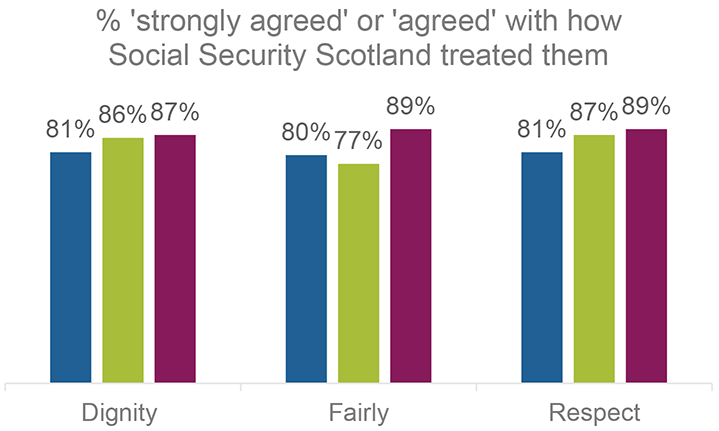
A key factor that emerged across both interviews with clients and support organisations that contributed towards clients’ belief that they would be treated in this way came from the reassurance that they would not be required to undergo a face-to-face assessment. One support organisation summarised their overall experience:
“A lot of people are surprised they’re not having to go for assessments, and that the document they get through at the end of their journey is quite substantial. It goes into a lot of detail about how the decision has been made, and I think that’s quite reassuring for people, a lot more dignified and respectful. A lot of the time they’re [Social Security Scotland] getting information from medical professionals, who know their condition and how it affects them. It’s kind of what we dreamed and hoped would happen. We’ve supported people with PIP and DLA – the difference between them is quite substantial.” (Support Organisation)
Progress towards long-term outcomes
This section focusses on individuals’ attitudes towards Social Security Scotland beyond the case transfer and review process. It explores to what extent their experiences had impacted on their views and interactions with Social Security Scotland going forward.
The long-term outcomes explored in this section include:
- Individuals trust in Social Security Scotland
- There are open and effective communications between individuals and Social Security Scotland
- Public services treat people with dignity and respect
- Individuals understand their responsibilities and feel more comfortable about reporting a change in circumstances
Two of the outcomes identified within the logic model require further research and data gathering. These outcomes are: ‘There is reduced stigma around illness and disability’ and ‘The right decision is made first time by Social Security Scotland’. These relate to the wider impacts of policy changes made to date in the delivery of disability benefits in Scotland. An evaluation of these outcomes therefore needs to be explored in combination with the full suite of policy changes. Furthermore, whilst data on re-determinations and appeals alongside survey data on the proportion of clients who agreed or disagreed with their decision would go some way to assessing whether the right decision is made first time, this is not currently available to be disaggregated for the first review completed by case transfer clients.
Individuals trust in Social Security Scotland
From the client survey, 71 per cent of clients with awards transferring from PIP to ADP; 78 per cent of those with awards transferring from DLA to ADP; and 81 per cent of those with awards transferring to CDP ‘strongly agreed’ or ‘agreed’ that they felt they could trust Social Security Scotland. There were no differences between those transferring from different benefits (see Figure 9).
Interviews with clients found that trust in Social Security Scotland was related to both positive experiences of dealing with staff during the case transfer and review process as well as a positive review outcome.
“I fully trust them. They are just better at explaining and letting you know what to expect from them, what to expect from the services.” (DLA client)
However, those that were still waiting on a review outcome were more likely to reserve caution about how much they trusted Social Security Scotland.
“I think so far I trust them, [I have] no reason not to.” (DLAC client)
The impact of the case transfer and review process on clients’ trust in Social Security Scotland may therefore take some time before it can be fully assessed. It will also be impacted by other interactions and experiences with Social Security Scotland and therefore best considered alongside other policy changes.
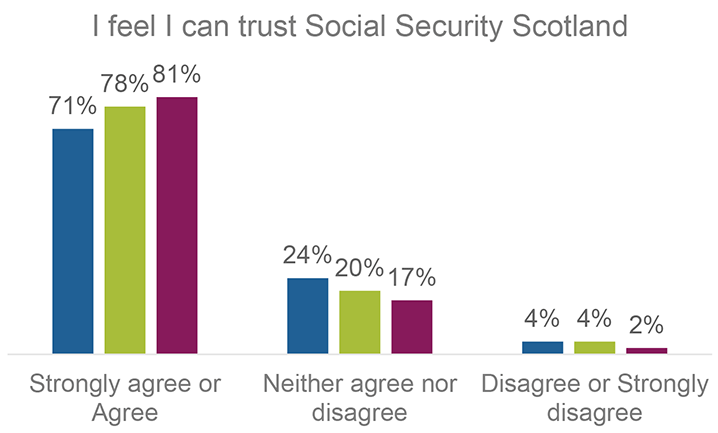
There are open and effective communications between individuals and Social Security Scotland
This long-term outcome relates to clients’ views on how easy it was to communicate with Social Security Scotland and whether there were any barriers.
In interviews with clients, there were mixed views about the amount of communication they had received from Social Security Scotland. On the one hand, there were clients who felt they had received the right level of communication and could approach staff with queries. However, there were others who felt they had had too little communication and would have liked to have received updates or information about their case transfer or review as it progressed. Those who had felt these processes had taken a long time were more likely to have wanted to have received more communication.
Only a small proportion of client survey respondents (5 per cent) reported a barrier in the form of communication i.e. not being able to communicate with Social Security Scotland when and how they wanted to. Those transferring to ADP were more likely to indicate they could not communicate with Social Security Scotland when and how they wanted to compared to those transferring to CDP.[9]
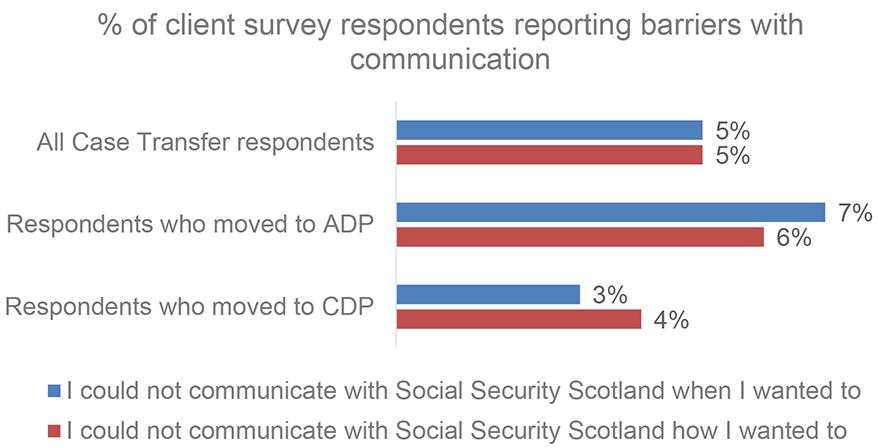
Overall, in the interviews, clients were more positive about the communications they received from Social Security Scotland compared with the DWP, with tone, more modern style and content all highlighted as key differences. The letters were perceived to be more personalised and modern-looking compared to the communication from the DWP which were seen as more traditional-looking and typewritten. The letters were also thought to be more accessible because of the larger font, use of more direct language, and inclusion of clearer signposting to information and support.
Some clients also reported feeling more hopeful and less anxious when dealing with Social Security Scotland.
“I felt I’d moved on to a better system, so don’t have same anxiety now. I previously thought about the DWP, ‘do I dare ring them up or just try to avoid them?’” (DLA client)
Public services treat people with dignity and respect
Client survey respondents were asked to rate their overall experience of Social Security Scotland. The majority of case transfer clients (87 per cent) rated their experience as ‘Very good’ or ‘Good’. There was some evidence of differences across the benefit that clients were transferring from with 77 per cent of those transferring from DLA to ADP indicating their experience was ‘very good’ or ‘good’ compared to 92 per cent of those transferring to CDP. However, there was no difference in those reporting their experience as ‘very poor’ or ‘poor’.
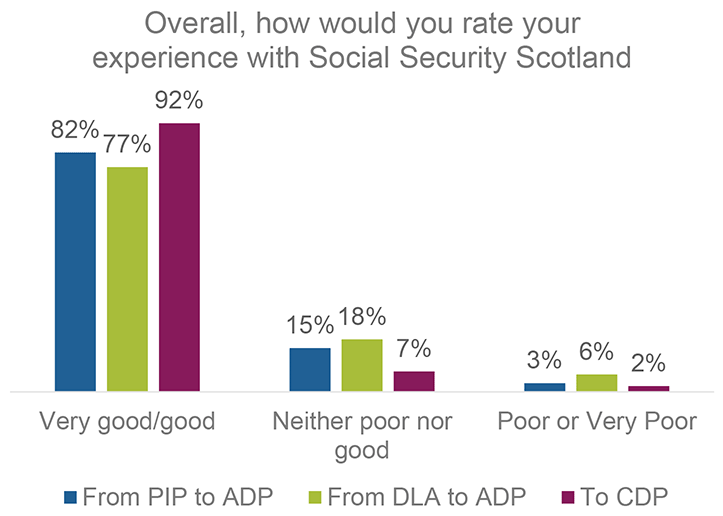
Interviewed clients reflected positively on their overall experience with Social Security Scotland. Some clients also noted the differences between their experiences compared to the DWP. As mentioned earlier, the commitment to the principles of dignity, fairness and respect seemed to underpin clients’ expectations that their experiences would be better.
“The words dignity, fairness and respect on the letter are good to see. It’s not good to have to claim benefits and [it’s] reassuring having that on there. It’s a good message.” (DLAC client)
Whilst clients’ experiences of issues or problems tended to reduce their overall dissatisfaction with Social Security Scotland, overall there was a sense that clients’ felt they had been treated positively, with clients describing staff as friendly, helpful, respectful, compassionate, and reliable.
“The Social Security Scotland people are chalk and cheese compared to the DWP people. Really helpful, always prepared to listen, without exception. They went above and beyond to help, I never felt I was troubling them […] [It] gives you a bit of respect when people talk to you like an equal adult.” (DLA client)
Individuals understand their responsibilities and feel more comfortable about reporting a change in circumstances
Evidence relating to this long-term outcome comes from interviews with clients. Further data is required to assess and understand this long-term outcome.
Clients generally said that they would know what to do if they had to report a change of circumstances to Social Security Scotland in future. Even when not sure, clients were confident that they would be able to find out by searching online or calling Social Security Scotland and would feel “relaxed” about the prospect.
Those who had been through the review process said they would feel comfortable reporting a change of circumstances. Some of those who had found the review forms onerous and/or the whole process too lengthy assumed that it would be easier the next time around. Others who had not yet had a review felt comfortable about the prospect because of their positive interactions with staff.
“I would feel very comfortable. They’re human, professional and they’re not patronising. [They] explain things in a way that’s understandable.” (DLAC client)
However, there were others who said they would not feel comfortable reporting a change of circumstances. There were a number of reasons for this:
- A worry that reporting it would lead to a change in award.
“I’d feel nervous because in back of mind you have that niggle that it might result in a change.” (DLAC client)
- Concerns about the length of time a review of their change in circumstances would take, particularly among those who had experienced a review with Social Security Scotland and felt it had taken a long time.
- A broader discomfort based on past experiences completing reviews (regardless of the agency conducting them) where they were considered to be lengthy and emotionally exhausting processes.
“I wouldn’t feel comfortable because I don’t like change. To do the form again would be very stressful. Anything related to benefits stresses me out. But Social Security Scotland I know I won’t lose it [the award] where with [the] DWP I think I would.” (DLA client)
Nevertheless, clients mentioned feeling more comfortable dealing with Social Security Scotland because they felt more respected and trusted by the agency compared to the DWP, who they felt “interrogated” by. With the prospect of reporting a change of circumstances in future, there was also sense of security with Social Security Scotland and less of a worry about payments stopping suddenly.
“[I feel] safer, less likely to get [payments] withdrawn. [There is] less ulterior motive to cut payments.” (DLAC client)
Contact
Email: socialresearch@gov.scot
There is a problem
Thanks for your feedback